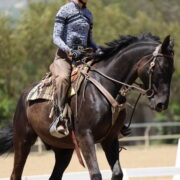What If Whips Were Banned?

The discussion over the excessive use of whips in the sport of horse racing has long been a contentious issue. Individual racing authorities have discussed it thoroughly – are whips necessary? How many strikes is one too many? Does over-hand versus under-hand jockey methods really matter?
With heightened scrutiny over horse deaths, the shaken racing industry has seen some major changes in the last year. Whip use is one of them. California passed one of the most stringent rules limiting whip use in the sport in June – jockeys can strike the horse up to six times in a race – limited to twice in succession – and only in an underhanded fashion. Earlier this year, a racing league in England banned whip use for encouragement purposes.
Horse racing is, of course, a whole different animal than the Olympic disciplines of equestrian sport. It’s at best, an apples to oranges comparison, to pit one industry’s breeding, training, care and competition practices against the other. But this recent news and ongoing probe into horse racing got me thinking – what if whips were banned by the FEI or USEF?
The thought seems ludicrous on face value. The way whips are used “for encouragement” over fences or in the dressage arena is hardly the same as jockeys pushing a Thoroughbred down the homestretch. But to the outfacing public eye – to the people who see the sport and aren’t horsemen – what is the difference?
It’s nuance. Whips, crops, “carrot sticks”, whatever you want to call them, have been used as a humane training tool for generations. They are meant as a guide, to provide a subtle reminder, for encouragement on where and how to move the body. Dressage trainers often describe them as an “artificial aid,” meant to reinforce the natural aids of the leg, seat and hands. It can be used to teach a horse personal space through groundwork, or even to help sharpen the placement of the legs during piaffe. And in other cases, the whip can be used for forward motion encouragement or to provide a bit of sharp confidence leading up to a spooky fence.
The research on how effective “whipping” is is squishy. One study suggests using the crop less “goes against operant training.” Other groups claim the practice is archaic and abusive.
Is using the whip to enforce dominance a negative reinforcement? Probably. But is tapping your horse on the haunches to remind him to use his hind-end through a leg-yield abuse? Of course not.
But like any tool in the wrong hands, it can be harmful. What matters most is a gentle, understanding hand and optics in the sport that put the horse’s health first and foremost. Horse sports are niche and strange. We’ll never be primetime. But as people catch Olympic reruns on TV or visit a horse show in a major metro venue, they should never look at the stick in the rider’s hand and see something they thought was cruel enough to ban in racing.


